Lawn weeds with red flowers are less common than weeds with white or pink flowers. Because these eye-catching weeds are fairly uncommon, identification is more likely.
I have made a list of 6 most common lawn weeds with red flowers:
- Red Sorrel (Rumex acetosella)
- Scarlet Pimpernel (Anagallis arvensis)
- Broad-Leaved Dock (Rumex obtusifolius)
- Tropical Milkweed (Asclepias curassavica)
- Red Witchweed (Striga Asiatica)
- Crimson clover (Trifolium incarnatum)
Dive into this article and find out everything you need about the most common lawn weeds with red flowers.
What we cover
ToggleMost common lawn weeds with red flowers
#1. Red Sorrel (Rumex acetosella)
Botanical name: Rumex acetosella
Blooming period: March to November
Other common names: Roselle, Jamaican sorrel, Indian sorrel
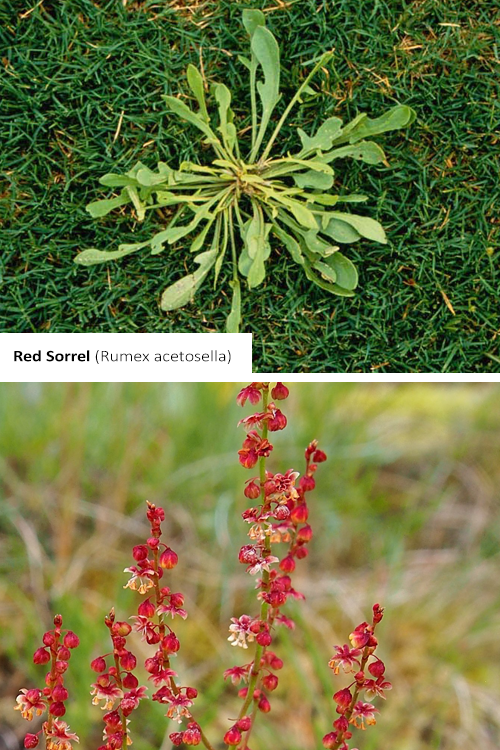
Control of Red Sorrel can be very difficult because it spreads aggressively by rhizomes and seeds. If you don’t remove or kill the whole root system it can remain viable in the soil for over 25 years.
The Red Sorrel plant is characterized by a slender, branched red stem that can grow up to 20 inches tall. The weed blooms from March to November with small flowers growing around the branches. The female plants produce dark red flowers and the male plants produce yellowish-green flowers.
Red sorrel grows well in acidic or nutrient-poor soils, and if red sorrel has started to take your yard it is a good time to check the pH of the soil. If the results show acid soil make necessary adjustments that encourage the growth of desirable plants.
#2. Scarlet Pimpernel (Anagallis arvensis)
Botanical name: Anagallis arvensis
Blooming period: March-May and August-September
Other common names: Red pimpernel and Red
chickweed
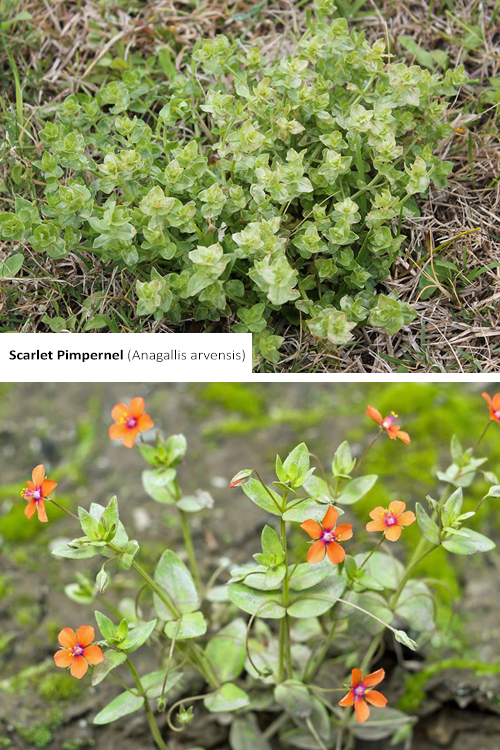
You can easily control scarlet pimpernel by regular mowing. Also pastures, agricultural land, and other open areas can be a home for this weed.
The common mistake with a scarlet pimpernel is that people sometimes mistake this weed with common chickweed because of the small leaves that look similar. The scarlet pimpernel is a low-growing plant that thrives in damp soil and can grow up to 8 inches in height with square-shaped steams.
It flowers from June to September with small orange or red flowers containing 5 petals. Most of the time the flowers are closed and only open when the sunshine.
#3. Broad-leaved Dock (Rumex obtusifolius)
Botanical name: Rumex obtusifolius
Blooming period: June to September
Other common names: Bitter dock, butter dock, and bluntleaf dock
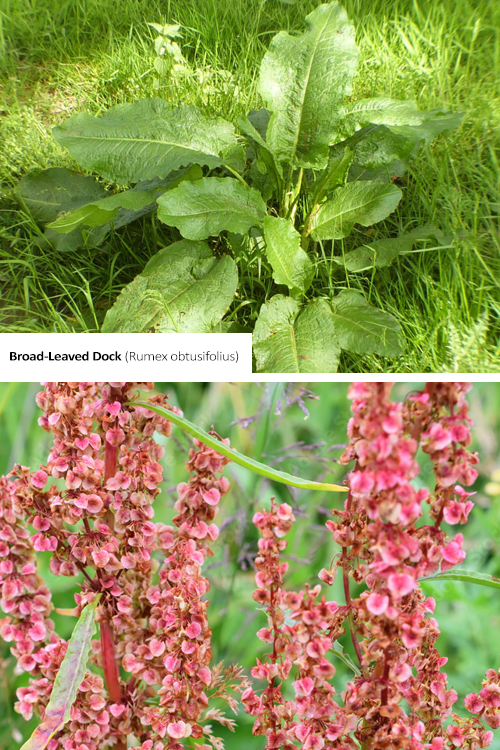
Broad-leaved Dock blooms from June to September. The flowers occur in panicles on long, upright stalks that rise above the leaves from the center of the plant. First flowers have a greenish color that gradually changes to a brownish-red.
Large and oval leaves are characteristic of this weed. Leaves are larger at the base than at the rounded tips. Usually, leaves have wavy edges and very often lower leaves have red stems.
Broad-leaved dock is very hard to completely eradicate due to the fact that spreads through seeds and rhizomes and each plant is capable of producing around 60,000 seeds that remain viable in the soil for up to 80 years, germinating when the conditions are right.
#4. Tropical Milkweed (Asclepias curassavica)
Botanical name: Asclepias curassavica
Blooming period: June to August
Other common names: Red-head cotton bush, Bloodflower, Mexican butterfly weed, and Scarlet milkweed
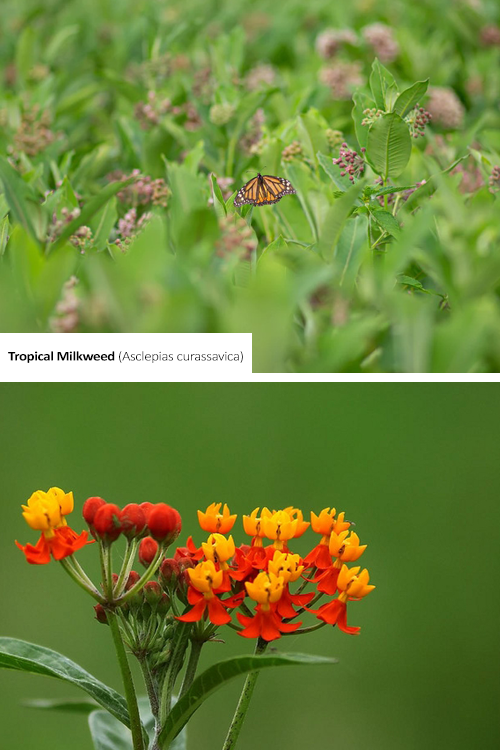
This weed is often grown by gardeners as an ornamental plant but can be found growing as a weed in fields, pastures, and along roadsides as well. It is native to Central America and can be found in the southern states of the US as an introduced species.
The weed has small flowers, 5-petalled, that grow in clusters with orange and red colors. The corona of the flowers is orange and grows inside the red petals, looking like another set of petals that face the flower center. It grows around 3-4 feet tall with branched or simple stems with medium green leaves that are narrow with points at both ends. The leaves can grow up to 6 inches in length.
#5. Red Witchweed (Striga Asiatica)
Botanical name: Striga Asiatica
Blooming period: May to August
Other common names: Asiatic witchweed, Striga
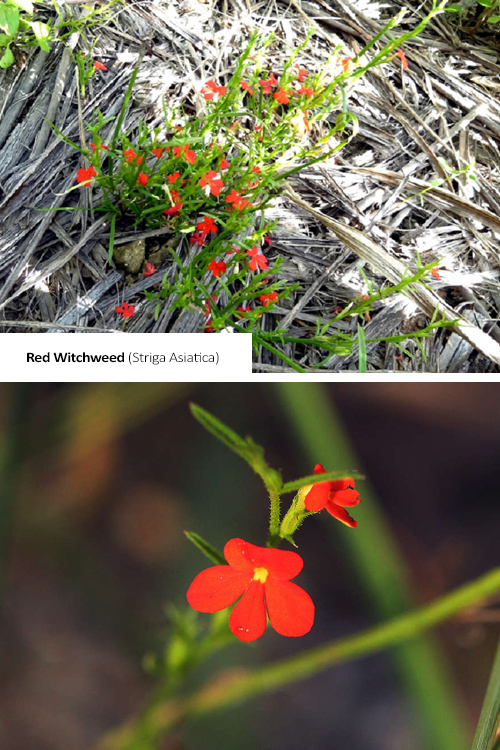
You can find Red Witched as a native lawn weed in Asia and sub-Saharan Africa, while as an introduced plant in the United States and Australia.
Red witched grow on the roots of certain types of grass as well as on some commercially important species so it is known as a parasitic weed. It usually grows up to 12 inches tall, with green hairy stems and narrow lanceolate leaves that are about an inch long.
While it produces small red flowers in summer and fall, sometimes it is a weed with white, purple, or yellow flowers. Following the flowers, seeds develop, each containing thousands of tiny seeds.
#6. Crimson Clover (Trifolium incarnatum)
Botanical name: Papaver rhoeas
Blooming period: spring to summer
Other common names: Italian clover
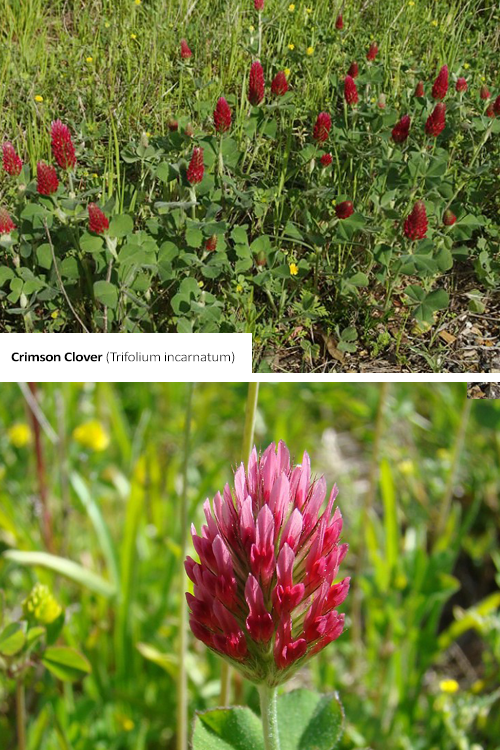
Crimson clover AKA Italian or scarlet clover is well known as a forage crop for livestock and cattle. Sometimes it’s become an invasive weed that displaces desirable vegetation.
The flowering season of this weed is from spring to summer with tiny red flowers that grow about 10 to 13 mm long with each flower having 5 petals. The flowerhead of the plant is a composition of about 40 to 50 flowers in a cluster. Crimson clover grows between 8 to 20 inches tall, with trifoliate leaves that are connected to the stem by a long petiole. Each leaflet is heart-shaped and hairy.
